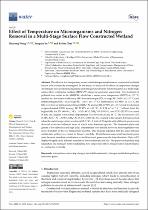| dc.description.abstract | The effect of low temperature on microbial nitrogen metabolism in constructed wetlands has yet to be extensively investigated. In this study, we analyzed the effects of temperature changes on nitrogen-associated microorganisms and nitrogen metabolism functional genes in a multi-stage surface flow constructed wetland (MSSFCW) using metagenomic sequencing. The treatment of polluted river water in the MSSFCW, which had a mean water temperature (MWT) of ≤17 °C, resulted in a low removal efficiency (RE) for total nitrogen (TN; average RE: 23.05% at 1–17 °C) and nitrate nitrogen (NO3−-N; average RE: −2.41% at 1–17 °C). Furthermore, at a MWT of ≤11 °C, the REs were low for ammonium nitrogen (NH4+-N; average RE: 67.92% at 1–11 °C) and for chemical oxygen demand (COD; average RE: 27.45% at 1–11 °C). At 0.24 m3 m−2 d−1 influent load, the highest REs for TN (66.84%), NO3−-N (74.90%), NH4+-N (83.93%), and COD (52.97%) occurred in July and August, when water temperatures were between 26 and 28 °C. | en_US |

